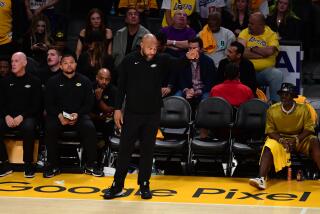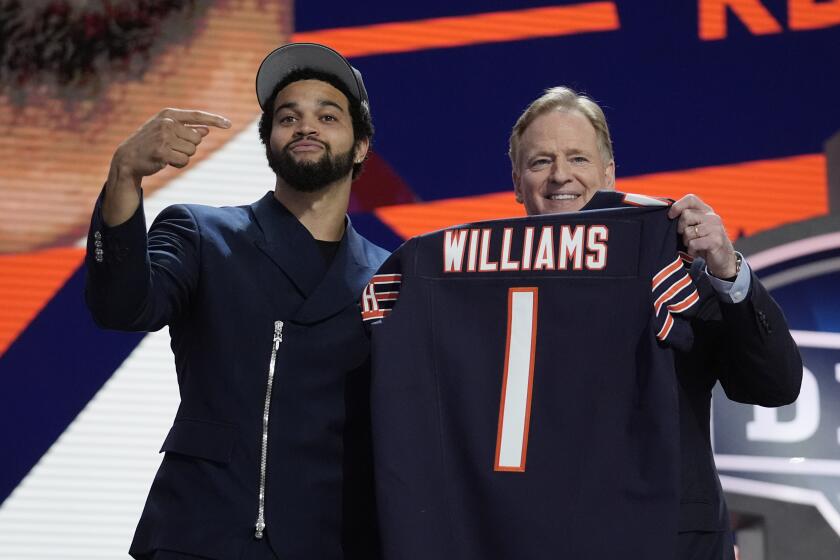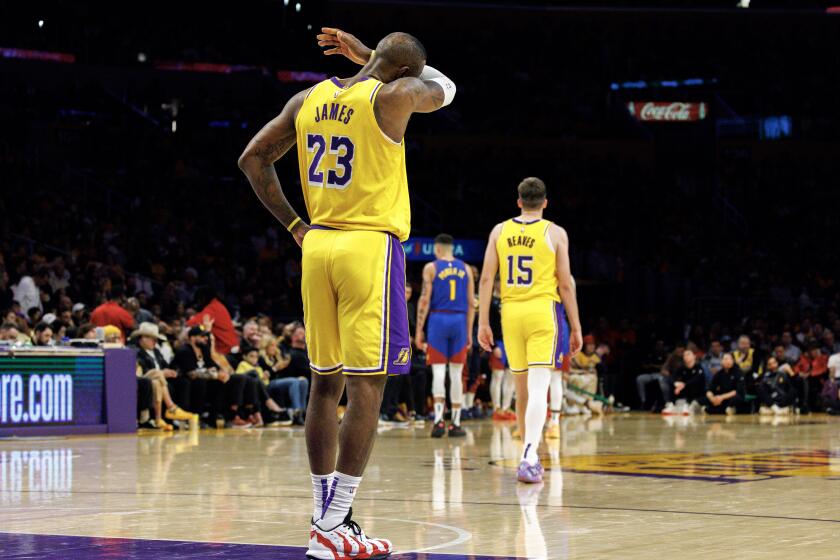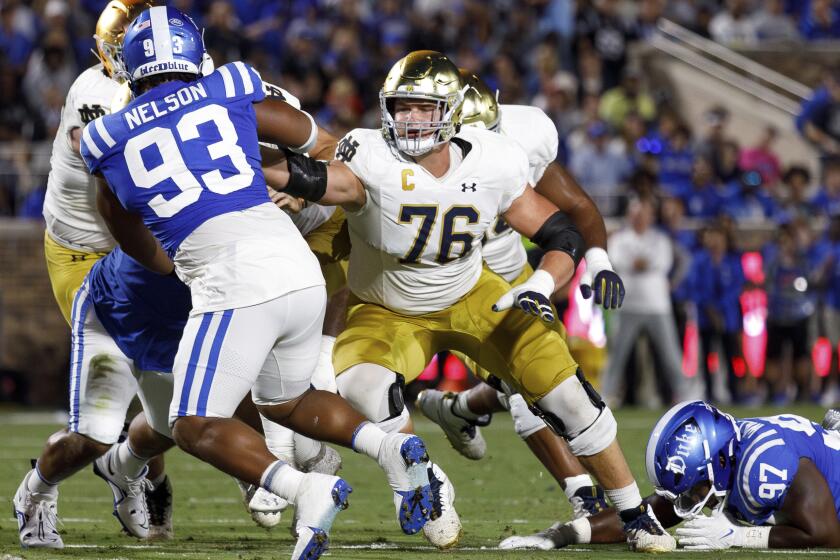Big Ten Network finds starting up is a challenge
The battle over the new Big Ten Network started to heat up around the beginning of summer. That’s when a major cable company questioned whether there was the need for a 24-hour channel devoted to a single athletic conference.
Not just football and basketball games, but also softball, soccer and diving. And studio shows to dissect it all.
That’s when conference Commissioner Jim Delany accused a cable executive of denigrating women’s sports and asked for an apology. Then fans started expressing their anger and worry on Internet message boards.
Soon, the University of Iowa got into the act, sending a mass e-mail that encouraged Hawkeyes alumni to complain to their cable systems.
There is nothing new about tense negotiations between a start-up network and the cable systems that might carry its programs. But the Big Ten Network marks the first time a major athletic conference has experimented with generating television coverage that goes well beyond what already appears on established channels.
The mixture of hot-blooded fans and cold, hard TV bucks appears to have upped the ante.
“Clearly, it’s getting personal,” said Neal Pilson, the former president of CBS Sports who is now an industry consultant.
The other conferences are curious about how this minidrama plays out. If the Big Ten is successful, it might open a revenue stream worth hundreds of millions of dollars.
“We’re going to keep an eye on it,” said Duane Lindberg, a Pacific 10 associate commissioner. “The reward of owning your own network can be substantial.”
The Big Ten comprises 11 universities in eight Midwestern states and -- with Michigan, Ohio State, Indiana and Penn State among its schools -- a stockpile of sports lore and followers.
Conference executives recently signed a 10-year, $1-billion contract with ABC and ESPN but figured there were plenty of games left beyond what major networks were interested in. So they partnered with Fox Cable Networks to build a downtown Chicago headquarters and obtain broadcast rights from their member schools.
The resulting network, which launches Aug. 30, will offer about 400 live events this school year, including 38 football games and 125 men’s basketball games that established networks aren’t showing. There will be 55 women’s basketball games, at least 170 events in sports ranging from baseball to hockey, coaches shows and replays of classic games.
The hard part is persuading scores of cable systems throughout the Midwest and the rest of the nation to carry all that programming.
In the cable industry, networks profit not from advertising but from charging each cable system a fee based on subscribers. The Big Ten is asking systems within its territory to pay $1.10 per subscriber. The price drops to 10 cents beyond that footprint.
With an estimated 17 million cable subscribers in Big Ten country alone, the potential revenue could far exceed $220 million a year.
Price is a sticking point. While ESPN gets a reported $3 per subscriber, other networks go for much less and industry analysts say $1.10 is expensive for a start-up.
A network spokesman said the price is negotiable.
Placement is another area of contention. The conference wants its channel on expanded basic cable in the eight states, as opposed to a premium tier that would carry an extra charge and attract fewer viewers.
So far, the network has deals with about 80 small cable companies, DirecTV and AT&T;’s new U-verse. Major systems in the Midwest -- including Comcast, Time Warner and Mediacom -- have yet to join.
“Cable operators hate all these sports networks that are charging huge licensing fees,” said Derek Baine, an analyst with SNL Kagan. “It’s eating into their margins.”
The cable companies would prefer to place the channel on the premium tier.
In late June, Delany chastised a senior Comcast executive for publicly commenting on the limited appeal of Iowa women’s volleyball games.
“I don’t know how those remarks go on the East Coast, but in the Midwest, when you’re talking about women’s sports teams, you talk about them with respect,” Delany told reporters.
But no Comcast executive ever made that comment. Instead, the company -- which has about 5.7 million subscribers in Big Ten states -- had circulated a handout suggesting that basketball fans in other states might not be interested in watching Iowa volleyball.
“This isn’t the Big Ten versus Comcast,” said Comcast spokeswoman D’Arcy Rudnay. “We really see this as the Big Ten versus the consumer.”
Regardless, the University of Iowa joined the fray, sending that e-mail with a toll-free number that connects fans to their local cable systems.
“I think everyone knew it would be a difficult process,” said Mike Vest, a network spokesman. “It has become more public than we would have liked. That’s been the part that has been a little surprising and a little disappointing.”
This is not the first time a conference has ventured into such territory. Last fall, the Mountain West Conference partnered with Comcast to launch The Mtn. on a regional scale, building from six or seven cable systems to its current total of almost 20.
Though no ratings were available, General Manager Kim Carver characterized the first season as a success. Still, she is not sure the idea would succeed everywhere.
“We have a region where not all of the states have pro teams,” said Carver, whose conference includes Nevada, New Mexico and Wyoming. “I think it depends on how much noise is out there.”
Pilson thinks there is room on the crowded TV dial for more sports channels. The Southeastern Conference has discussed the idea and will be free of existing television contracts within a few years, a spokesman said.
The Pac-10 is locked into a different system, Lindberg said. Conference officials negotiated long-term deals for all their best games; everything else reverts to individual schools, which can strike their own local deals.
This structure will remain in place through the 2011-12 school year, Lindberg said. Nevertheless, the conference’s television committee will discuss the issue later this fall.
In the meantime, analysts predict the Big Ten will reach agreements with Comcast and other hold-out systems, probably at a lower price. But those deals might not be in place for start of football season next week.
And that could ignite more fireworks in coming days. As Rudnay said: “Sports fans do tend to be passionate.”
More to Read
Get our high school sports newsletter
Prep Rally is devoted to the SoCal high school sports experience, bringing you scores, stories and a behind-the-scenes look at what makes prep sports so popular.
You may occasionally receive promotional content from the Los Angeles Times.







